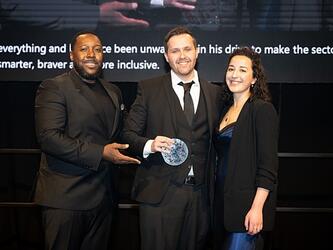Challenge everything
Ask yourself this: What does your business stand for, or what does it stand against? If you don’t have an answer to either question, you might be in trouble. Adam Morgan, one of the leading lights of British brand planning and the author of Eating the Big Fish, thinks companies need to be challenging something in order to grow.
We often think of challenger brands as small, spunky upstarts: little Davids battling against corporate Goliaths. But being a challenger has nothing to do with size, says Morgan. “It’s a mindset.”
His new book, Overthrow, (co-authored with Mark Holden of media agency PHD) identifies 10 different types of challenger brands, as well as the different types of stories they tell to customers in order to win market share.
So, which type of challenger are you going to be?
The people’s champion
They claim the moral high ground and seek to right wrongs and challenge the motives of the ‘establishment’. As a tactic, it’s been successfully and repeatedly employed by the Virgin brand.
The missionary
It’s not about what they do, but why they do it. “Businesses need soul, and the why is the soul,” says David Hieatt, founder of the Hiut Denim Company. Hieatt lives in Cardigan, Wales, which used to have a thriving denim industry. Creating Hiut returned 400 lost jobs to the town. That’s why he did it.
The irreverent maverick
Brands whose only real purpose is to create mischief and controversy. Think Paddy Power, Nandos or Red Bull. “They’re poking the bland and the beige in the eye, but they are living on the edge of uproar,” says Morgan.
The real and human challenger
Everyone knows Zappos – the online shoe shop that makes staff rank themselves on a weirdness scale and runs an internal contest to see how long call centre employees can keep customers chatting on the phone (the record is nine hours). These brands set out to feel ‘real’ in an otherwise faceless and impersonal category.
The game changer
These brands are on a mission to change the way people think about a category, promising a quantum leap forward in service or experience. Morgan gives the example of Airbnb, a service that lets people rent out extra space in their homes to travellers at prices significantly below that of hotels.
The democratiser
Challenging elitism is the democratiser’s guiding principle. They want to open up access to markets, products or services through radically lower price points.
The next generation
The message here is that new times call for new brands, and that incumbents – solid and familiar though they may be – are now outmoded. It’s a tactic Audi is employing in America, where it is challenging Mercedes Benz as a status symbol for the wealthy.
The enlightened zagger
Newcastle Brown Ale’s ‘No Bollocks’ campaign in the US says it all. This type of brand is one that runs counter to the prevailing trend and isn’t afraid to call “bullshit” when they see it, says Morgan.
The feisty underdog
A smaller player who’s taking on – and calling out – a bigger rival. The underdog here aims to reduce the world to a binary choice – one that positions it alongside the market leader in the mind of the consumer.
The visionary
These brands imagine bigger things for their category and set out to achieve it. Lark is an example of this: a wristband that was originally created to be a silent, personal, vibrating alarm clock, which has evolved into a device to help people monitor and improve their sleep patterns.
This article was first published in Impact, the new quarterly magazine from the Market Research Society. Follow the link to read the digital version of Impact.
Includes:
- A special report on customer experience
- Profiles of the Tate, SABMiller and Auto Trader, showing how they use data and insight to shape strategy and decision-making
- How the UK government’s Nudge Unit is changing policy development
- How hackathons can help data and analytics companies innovate

We hope you enjoyed this article.
Research Live is published by MRS.
The Market Research Society (MRS) exists to promote and protect the research sector, showcasing how research delivers impact for businesses and government.
Members of MRS enjoy many benefits including tailoured policy guidance, discounts on training and conferences, and access to member-only content.
For example, there's an archive of winning case studies from over a decade of MRS Awards.
Find out more about the benefits of joining MRS here.













0 Comments